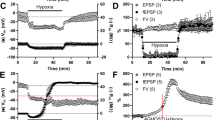Summary
Brain edema caused by glutamate excitotoxicity was studied in well oxygenated neonatal cerebrocortical brain slices (350 μthick). Slices exposed to 60 minutes of 2 mM glutamate, with or without glutamate antagonists (dizocilpine, kynurenate, or NBQX), were allowed to recover for 60 minutes. The protocol was identical to that in noninvasive multinuclear NMR spectroscopy studies (31P/1H/19F) of live slices. Percent water and swelling were determined invasively in isolated slices by wet and dry weight measurements before and after glutamate exposure. Edema was detectable within minutes in all experiments with glutamate exposures, but not in untreated control slices. Dizocilpine, kynurenate, and NBQX differently aftected swelling, which correlated with PCr and ATP loss in separate NMR studies. Synaptic glutamate receptor activation appears to initiate events causing both edema and energy failure. Multiple glutamate receptor types seem to be involved. No glutamate antagonist provided greater protection against both edema and energy loss than dizocilpine. Dizocilpine might also block voltage-dependent Na+ channels, and provide protection via mechanisms other than NMDA-receptor dependent channel antagonism.
Access this chapter
Tax calculation will be finalised at checkout
Purchases are for personal use only
Preview
Unable to display preview. Download preview PDF.
Similar content being viewed by others
References
Boisvert DPJ, Handa Y, Allen P S (1990) Proton relaxation in acute and subacute ischemic brain edema. Adv Neurol 52:407–413
Brandt-Zawadski M, Pereira B, Weinstein PR, Moore S, Kucharczyk W, Berry I, McNamara M, Derugin N (1986) MR imaging of acute experimental ischemia in cats. Am J Neuroradio l7:7–11
Chan P H, Fishman R A (1978) Brain edema: induction in cortical slices by polyunsaturated fatty acids. Science 201: 358–360
Chan P H, Fishman R A, Lee J L, Candelise L (1979) Effects of excitatory neurotransmitter amino acids on swelling of rat brain cortical slices. J Neurochem 33: 1309–1315
Dingledine R (1984) Brain slices. Plenum, New York
Espanol M T, Litt L, Yang G-Y, Chang L-H, Chan P K, James T L, Weinstein P R (1992) Tolerance of low intracellular pH during hypercapnia by rat cortical brain slices: a 31 P/1H NMR study. J Neurochem 59: 1820–1828
Espanol M T, Xu Y, Litt L, Yang G-Y, Chang L-H, James T L, Weinstein P R, Chan P K (1993) Modulation of glutamate-induced intracellular energy failure in cerebral cortical slices by kynurenic acid, dizocilpine, and NBQX. J Cereb Blood Flow Metab 13 [Suppl]: 748
Fishman R A (1975) Brain edema. N Engl J Med 293: 706–711
Ikeda Y, Long D M (1990) The molecular basis of brain injury and brain edema: the role of oxygen free radicals. Neurosurgery 27: 1–11
Kato H, Kogure K, Ohtomo H, Izumiyama M, Tobita M, Matsui S, Yamamoto E, Kohno H, Ikebe Y, Watanabe T (1986) Characterization of experimental ischemic brain edema utilizing proton magnetic resonance imaging. J Cereb Blood Flow Metab 6: 212–221
Le Bihan D, Turner R, Douek, Patronas N (1992) Diffusion MR imaging: clinical applications. Am J Roentgenol 159: 591–599
Mcllwain H, Buddle H L (1953) Techniques in tissue metabolism. 1. A mechanical chopper. Biochem J 53: 412–420
Moseley M E, Kucharczyk J, Mintorovitch J, Cohen Y, Kurhanewicz J, Derugin N, Asgari H, Norman D (1990) Diffusionweighted MR imaging of acute stroke: correlation with T2-weighted and magnetic susceptibility-enhanced MR imaging in cats. Am J Neuroradiol 11: 423–429
Naruse S, Horikawa Y, Tanaka C, Hirakawa K, Nishikawa H, Yosizaki K (1982) Proton magnetic resonance studies on brain edema. J Neurosurg 56: 747–752
Nowak L M, Wright J M (1992) Is there a role for slow voltagedependent changes in NMDA channel open state probability? In: Simon R (ed) Excitatory amino acids. Fidia research foundation Symposium Series, Vol 9. Thieme, New York, pp 113–115
Author information
Authors and Affiliations
Editor information
Editors and Affiliations
Rights and permissions
Copyright information
© 1994 Springer-Verlag
About this paper
Cite this paper
Espanol, M.T. et al. (1994). Modulation of Edema by Dizocilpine, Kynurenate, and NBQX in Respiring Brain Slices After Exposure to Glutamate. In: Ito, U., et al. Brain Edema IX. Acta Neurochirurgica, vol 60. Springer, Vienna. https://doi.org/10.1007/978-3-7091-9334-1_15
Download citation
DOI: https://doi.org/10.1007/978-3-7091-9334-1_15
Publisher Name: Springer, Vienna
Print ISBN: 978-3-7091-9336-5
Online ISBN: 978-3-7091-9334-1
eBook Packages: Springer Book Archive




